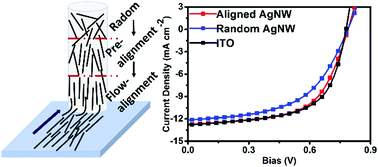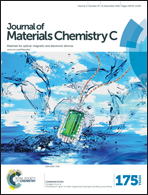Aligned silver nanowires as transparent conductive electrodes for flexible optoelectronic devices†
Abstract
Silver nanowire (AgNW) networks, which are promising alternatives to indium tin oxide (ITO) as transparent conductive electrodes, have been a recent focus in the application of flexible optoelectronic devices. For the purpose of improving the optical and electrical performance of the network, herein, a novel “capillary-assisted fluidic assembly” technique is proposed, which simply involves a one-step solution process. Using this technique, numerous individual nanowires are well aligned over a large area with controlled density. In addition, the network with aligned AgNWs is consequently constructed, possessing remarkably improved optical and electrical performance (Rs = 16.6 Ω sq−1, T@550nm = 92.7%) as compared to that with random AgNWs. Large-scale polymer solar cells are taken as an example to demonstrate the efficacy of this technique and the device based on aligned AgNWs exhibit a power conversion efficiency of 6.01%, which is much higher than that based on random AgNWs. Notably, this is the highest efficiency reported to date using AgNW electrodes with a device area of 1.0 cm2. It is further found that the aligned AgNW networks exhibit significantly better mechanical stability than the brittle ITO films. This technique, which is compatible with roll-to-roll processes, shows promising potential in the continuous fabrication of large-area flexible optoelectronic devices.


 Please wait while we load your content...
Please wait while we load your content...